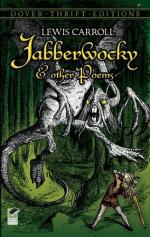|
This section contains 1,731 words (approx. 5 pages at 400 words per page) |

|
Levchuck, a writer and editor, has published articles on literature along with nonfiction essays and children's books. In this essay, she focuses on Carroll's "Jabberwocky" as the perfect portmanteau poem.
Lewis Carroll's poem "Jabberwocky" has long been categorized as a shining example of nonsense verse. Carroll employs what is called amphigory, which is, in essence, nonsense verse that appears to have meaning but in fact has none. This classification, however, should not be taken at face value to mean that the poem hasn't any meaning. In fact, "Jabberwocky" is rife with meaning (and meanings, because of Carroll's introduction of new words). It conveys not only a tale but also offers a commentary of sorts not only on Anglo-Saxon poetry but on the literature of the Victorian era in which Carroll created. It is a poem that works on two distinct levels, conveying different ideas, making it a...
|
This section contains 1,731 words (approx. 5 pages at 400 words per page) |

|




